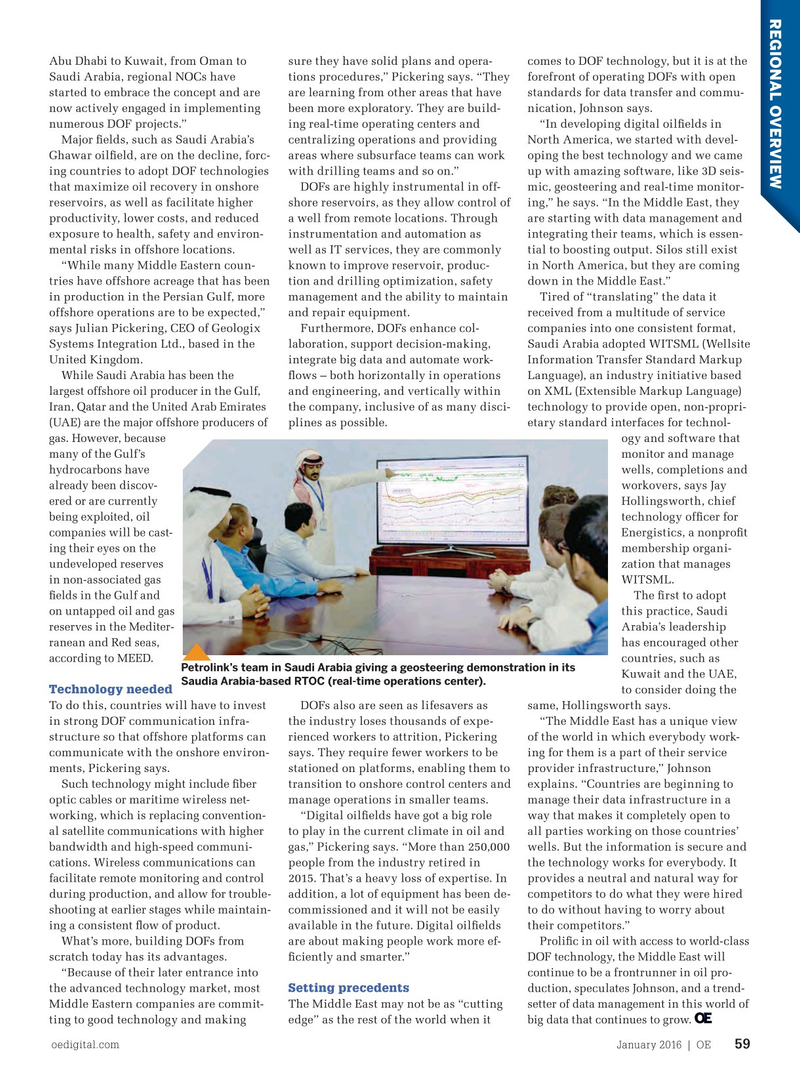
Page 57: of Offshore Engineer Magazine (Jan/Feb 2016)
Read this page in Pdf, Flash or Html5 edition of Jan/Feb 2016 Offshore Engineer Magazine
REGIONAL OVERVIEW
Abu Dhabi to Kuwait, from Oman to sure they have solid plans and opera- comes to DOF technology, but it is at the
Saudi Arabia, regional NOCs have tions procedures,” Pickering says. “They forefront of operating DOFs with open started to embrace the concept and are are learning from other areas that have standards for data transfer and commu- now actively engaged in implementing been more exploratory. They are build- nication, Johnson says. numerous DOF projects.” ing real-time operating centers and “In developing digital oil? elds in
Major ? elds, such as Saudi Arabia’s centralizing operations and providing North America, we started with devel-
Ghawar oil? eld, are on the decline, forc- areas where subsurface teams can work oping the best technology and we came ing countries to adopt DOF technologies with drilling teams and so on.” up with amazing software, like 3D seis-
REGIONAL OVERVIEW that maximize oil recovery in onshore DOFs are highly instrumental in off- mic, geosteering and real-time monitor-
Digital gains reservoirs, as well as facilitate higher shore reservoirs, as they allow control of ing,” he says. “In the Middle East, they productivity, lower costs, and reduced a well from remote locations. Through are starting with data management and exposure to health, safety and environ- instrumentation and automation as integrating their teams, which is essen- mental risks in offshore locations. well as IT services, they are commonly tial to boosting output. Silos still exist “While many Middle Eastern coun- known to improve reservoir, produc- in North America, but they are coming
Middle Eastern ground tries have offshore acreage that has been tion and drilling optimization, safety down in the Middle East.” in production in the Persian Gulf, more management and the ability to maintain Tired of “translating” the data it offshore operations are to be expected,” and repair equipment. received from a multitude of service says Julian Pickering, CEO of Geologix Furthermore, DOFs enhance col- companies into one consistent format,
Systems Integration Ltd., based in the laboration, support decision-making, Saudi Arabia adopted WITSML (Wellsite
United Kingdom. integrate big data and automate work- Information Transfer Standard Markup
While Saudi Arabia has been the ? ows – both horizontally in operations Language), an industry initiative based largest offshore oil producer in the Gulf, and engineering, and vertically within on XML (Extensible Markup Language)
Iran, Qatar and the United Arab Emirates the company, inclusive of as many disci- technology to provide open, non-propri- (UAE) are the major offshore producers of plines as possible. etary standard interfaces for technol- gas. However, because ogy and software that many of the Gulf’s monitor and manage hydrocarbons have wells, completions and already been discov- workovers, says Jay ered or are currently
Hollingsworth, chief being exploited, oil technology of? cer for companies will be cast-
Energistics, a nonpro? t ing their eyes on the membership organi- undeveloped reserves zation that manages in non-associated gas
WITSML. ? elds in the Gulf and
The ? rst to adopt on untapped oil and gas this practice, Saudi reserves in the Mediter-
Arabia’s leadership ranean and Red seas, has encouraged other according to MEED. countries, such as
Petrolink’s team in Saudi Arabia giving a geosteering demonstration in its
Kuwait and the UAE,
Saudia Arabia-based RTOC (real-time operations center).
Technology needed to consider doing the
To do this, countries will have to invest DOFs also are seen as lifesavers as same, Hollingsworth says. in strong DOF communication infra- the industry loses thousands of expe- “The Middle East has a unique view structure so that offshore platforms can rienced workers to attrition, Pickering of the world in which everybody work- communicate with the onshore environ- says. They require fewer workers to be ing for them is a part of their service ments, Pickering says. stationed on platforms, enabling them to provider infrastructure,” Johnson
Such technology might include ? ber transition to onshore control centers and explains. “Countries are beginning to optic cables or maritime wireless net- manage operations in smaller teams. manage their data infrastructure in a working, which is replacing convention- “Digital oil? elds have got a big role way that makes it completely open to al satellite communications with higher to play in the current climate in oil and all parties working on those countries’ bandwidth and high-speed communi- gas,” Pickering says. “More than 250,000 wells. But the information is secure and cations. Wireless communications can people from the industry retired in the technology works for everybody. It facilitate remote monitoring and control 2015. That’s a heavy loss of expertise. In provides a neutral and natural way for during production, and allow for trouble- addition, a lot of equipment has been de- competitors to do what they were hired shooting at earlier stages while maintain- commissioned and it will not be easily to do without having to worry about ing a consistent ? ow of product. available in the future. Digital oil? elds their competitors.”
Proli? c in oil with access to world-class
What’s more, building DOFs from are about making people work more ef-
DOF technology, the Middle East will scratch today has its advantages. ? ciently and smarter.” continue to be a frontrunner in oil pro- “Because of their later entrance into
Setting precedents duction, speculates Johnson, and a trend- the advanced technology market, most setter of data management in this world of
Middle Eastern companies are commit- The Middle East may not be as “cutting big data that continues to grow. ting to good technology and making edge” as the rest of the world when it oedigital.com January 2016 | OE 59 058_OE0116_Geo2_Heather.indd 59 12/24/15 1:42 PM

 56
56

 58
58